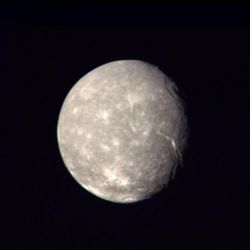Titania
| Titania | |
|---|---|
 Titania in color, taken by Voyager 2 | |
| Date of discovery | January 11, 1787[1] |
| Name of discoverer | William Herschel[1][2] |
| Name origin | Queen of the fairies in the play A Midsummer Night's Dream by William Shakespeare |
| Orbital characteristics | |
| Primary | Uranus |
| Order from primary | 17 |
| Periuranion | 434,951 km[3] |
| Apuranion | 436,869 km[3] |
| Semi-major axis | 435,910 km[4] |
| Orbital eccentricity | 0.0022[4] |
| Sidereal month | 8.705872 da[4] |
| Avg. orbital speed | 3.65 km/s[2] |
| Inclination | 0.14°[4] to Uranus's equator |
| Rotational characteristics | |
| Sidereal day | 8.705872 da[4] |
| Rotational speed | 0.006589 km/s[3] |
| Axial tilt | 0°[4] |
| Physical characteristics | |
| Mass | 3.52*1021 kg[4] |
| Density | 1710 kg/m³[4] |
| Mean radius | 788.9 km[4] |
| Surface gravity | 0.3781 m/s²[3] |
| Escape speed | 0.768 km/s[2] |
| Surface area | 7,820,847 km²[3] |
| Mean temperature | 60 K[5] |
| Composition | Water ice and rock[6] |
| Color | Light brown-gray |
| Albedo | 0.28[4] |
Contents
Discovery and naming
William Herschel discovered Titania and its next companion, Oberon, on January 11, 1787.[1]
Sir John Herschel, his son, gave to Titania the name of the queen of the fairies in William Shakespeare's comedy, A Midsummer Night's Dream.[1][7]
Orbital characteristics
Titania is in a somewhat eccentric orbit around Uranus at an average distance of 435,910 km. Its sidereal month is about 8.71 Earth days.
Rotational characteristics
Titania is in tidal lock with Uranus.
Physical characteristics
Titania has the greatest mass, diameter, and density of all the moons of Uranus. It is probably composed of water ice and rock, with a significantly higher proportion of rock than that of other moons of Uranus.[6]
Surface
Titania contains many fault-like interconnected valleys, an indication of significant tectonic activity.[2][6] Some of these valleys are hundreds of kilometers in length. Perhaps the longest of these valleys is a trench measuring 1,600 km in length. This trench is comparable in size to Ithaca Chasma on Tethys.
The surface is considered relatively "young" by uniformitarian standards. Some astronomers speculate that Titania was once liquid, and then froze, with the surface freezing before the interior.[6]
Atmosphere
On September 8, 2001, at about 0200 UTC, Titania occulted the star Hipparcos #106829 (SAO 164538). Astronomers at the Observatoire Paris-Meudon used the data from this occultation to set an upper limit on the atmosphere of Titania, if it has one. That atmosphere can have no higher pressure than 0.03 microbar.[5][8]
Problems for uniformitarian theories posed by this body
Titania poses the same problem for uniformitarian astronomy as do all the other moons of Uranus: its orbit is inclined severely to the ecliptic, though not to Uranus' own equator. How the Uranian system came to have such an inclination has never been explained.
Observation and Exploration
The only spacecraft to explore Titania has been Voyager 2. It approached to within 365,200 km of Titania on January 24, 1986, and took a small number of images.[9][10] No other detailed images are available.
Gallery
References
- ↑ 1.0 1.1 1.2 1.3 "Gazetteer of Planetary Nomenclature: Planetary Body Names and Discoverers." US Geological Survey, Jennifer Blue, ed. March 31, 2008. Accessed April 17, 2008.
- ↑ 2.0 2.1 2.2 2.3 Hamilton, Calvin J. "Entry for Titania." Views of the Solar System, 2001. Accessed June 15, 2008.
- ↑ 3.0 3.1 3.2 3.3 3.4 Calculated
- ↑ 4.00 4.01 4.02 4.03 4.04 4.05 4.06 4.07 4.08 4.09 4.10 Williams, David R. "Uranian Satellite Fact Sheet." National Space Science Data Center, NASA, November 23, 2007. Accessed June 15, 2008.
- ↑ 5.0 5.1 Authors unknown. "Limit on an atmosphere for Titania." L'occultation de l'étoile Hipparcos #106829 (SAO 164538) par Titania le 8 septembre 2001, Observatoire de Paris-Meudon, France, n.d. Accessed June 15, 2008.
- ↑ 6.0 6.1 6.2 6.3 Arnett, Bill. "Entry for Titania." The
Nine8 Planets, December 11, 2004. Accessed June 15, 2008. - ↑ Lassell, William. "Beobachtungen der Uranus-Satelliten." Astronomische Nachrichten 34:325-328, 1852. Accessed June 12, 2008.
- ↑ Sicardy, Bruno, and Widemann, Thomas. "Is there an atmosphere around Titania, satellite of Uranus?" Observatoire Paris-Meudon, France, n.d. Accessed June 15, 2008.
- ↑ "Voyager Mission Description: Voyager 2 Uranus Encounter." February 19, 1997. Accessed June 13, 2008.
- ↑ Smith, B.A., Soderblom, L.A., Beebe, R., et al. "Voyager 2 in the Uranian system - Imaging science results." Science 233:43-64, July 4, 1986. Accessed June 13, 2008.
| |||||||||||||||||||||||||||||

